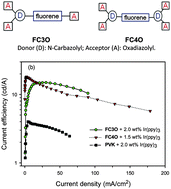Solution-processable bipolar host materials composed of fluorenyl, carbazolyl and 1,3,4-oxadiazolyl derivatives: synthesis and application in phosphorescent organic light-emitting diodes†
Abstract
Carrier transport in a host is crucial for enhancing the emission efficiency of phosphorescent organic light-emitting diodes (PhOLEDs). The study prepared two new solution-processable bipolar hosts (FC3O and FC4O) containing fluorenyl, hole-transporting carbazolyl and electron-transporting oxadiazolyl moieties to investigate their applicability to PhOLEDs. The ratios of oxadiazolyl over carbazolyl groups are 3/1 and 4/2 for FC3O and FC4O, respectively. It was found that both hosts reveal good thermal stability (Td > 360 °C, Tg > 145 °C) attributable to rigid and non-planar structures; moreover, homogeneous films (rms roughness <0.75 nm) were readily obtained by the spin-coating process. Multilayer green-emitting PhOLEDs were successfully fabricated (ITO/PEDOT:PSS/EML/BCP/LiF/Al), using FC3O or FC4O doped with Ir(ppy)3 as the emission layer (EML) which was deposited by the spin-coating process. The maximum luminance and maximum current efficiency of the FC4O-based device were 10 232 cd m−2 and 18.2 cd A−1, respectively, higher than 9358 cd m−2 and 14.9 cd A−1 of the FC3O-based one. Furthermore, both FC3O and FC4O outperform the conventional host PVK (1567 cd m−2, 4.0 cd A−1) in terms of device performance, indicating their potential for general applicability to hosts of organic light-emitting diodes.


 Please wait while we load your content...
Please wait while we load your content...